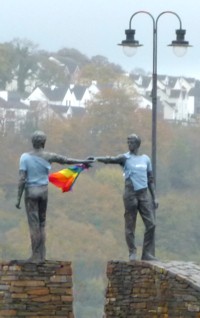Killarney
Killarney is away from the coast, about 90 km west of Cork. We had decided to make this a base for a side trip along the Dingle Peninsular. The hotel was modern, near the centre of town, convenient to pubs and shops, with a convenient car park. Killarney is famed for its parks and nearby lakes that have attracted tourists, holiday makers and ramblers to its hotels and grand houses since the time of Queen Victoria who spent time here. Among its notable buildings are St Mary's (Roman Catholic) Cathedral and the Franciscan Friary.
There was a wedding on at the Cathedral that delayed us having a look inside and then we tried to be inconspicuous. Strangely it was one of only two Roman Catholic churches we visited as almost all the older churches are Church of Ireland (Protestant). Not that there is a huge difference in the architecture. In this case construction was delayed by the 'Great Famine' and subsequent economic collapse and it was only 'reordered' (their description) to this high standard in 1973.
As it was a 'cathedral wedding' it was quite elaborate, and thus no doubt expensive. The happy couple emerged under an arch formed of hurling sticks held aloft by their male friends, presumably members of local hurling teams. The bride was in white and although not as expensively dressed or bejewelled, she was perhaps just as lovely as Meghan Markle had been at her wedding a few months earlier. But we agreed that in the Republic of Ireland elaborate weddings are not usually subsidised by diverting taxpayer resources from more urgent and less frivolous extravagances.
Across the road from the Friary is the Courthouse and a bronze sculpture of two Irish Red Stags with antlers locked. I imagined that this must be a sectarian metaphor but I was reading too much into it. I looked it up online. It simply celebrates efforts to save these animals from extinction or perhaps from being shot by itinerant English aristocracy. The Irish Times laments that the city was able to find seventy thousand Euros for this, implied frivolous extravagance, but couldn't afford to replace the temporary public toilets nearby.
See the Ireland Album - Click Here...

